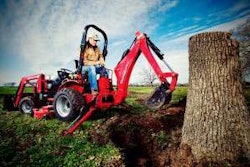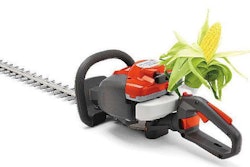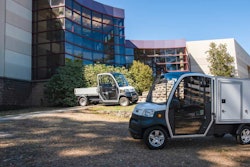Leaf blowers and edge trimmers spur noise ordinances. Here’s how manufacturers and others are coping with the sound and fury.
Landscape contractors are facing increasing pressure from homeowners associations, municipalities and other government agencies about equipment sound. Blowers are most often targeted, not only due to the sound level at which they operate, but especially their sound frequency. In some cases, communities have enacted limitations or even complete bans on blowers. In a national survey by Noise Free America, a nonprofit organization dedicated to fighting noise, gas-powered leaf blowers were voted the worst invention ever created.
“The official worst offender is the leaf blower, a relatively new tool that has other problems: It is too often used just to move leaves and trash around, and sometimes, onto the neighbor’s property or the street,” says Kim Sorvig, landscape architect and research associate professor, School of Architecture and Planning, University of New Mexico. “Much of the pressure for ordinances began after the popularization of blowers.” Sorvig’s research rated the typical gas blower at 110 decibels (dB), just below the pain threshold. Two-cycle engines are particularly noted to be discordant to the human ear.
Noise Ordinances Get Louder
The strictness of noise ordinances varies from city to city. Some cities have banned them altogether, where others have time enforcements. Enforcement is often responsive to public complaint.
The town of Chevy Chase, Maryland, for example, allows a maximum noise level at a receiving property line at 65 dB(A). The ordinance also states leaf blowers may not exceed 70 dB(A) at a distance of 50 feet at anytime. The town also restricts the hours in which construction and landscape work can be conducted.
In September 2010, the Santa Monica, California, city council voted to require their Office of Sustainability and the Environment (OSE) to enforce a leaf blower ban that has been in place for nearly a decade.
In Portland, Oregon, contractors wishing to operate their blowers year round must have equipment that produces 65 dB(A) or less.
Manufacturers of handheld equipment have responded to complaints of noise pollution in a variety of ways, primarily by citing the benefits of more fuel-efficient models, which sometimes, as a pleasant side effect, also reduce noise pollution.
Stihl has pioneered noise reduction design in its models.Two-cycle equipment has long dominated the professional turf maintenance equipment market, and there’s no shortage of these hardworking tools in use. And while four-stroke units tend to weigh in heavier than comparable two-stroke units due to the addition of an oil tank, oil pump and oil pan, four-stroke equipment offers improved fuel efficiency. With today’s unstable oil prices, which seem to rise every summer, this is a big attraction for landscapers running a lot of handheld equipment. Four-stroke engines also tend to be easier to maintain and more durable with a longer life span. They run cooler, which helps counter the increasing problem contractors find as they are forced to burn E15 gas in their equipment. And their lower decibel ratings are becoming a plus with LCOs operating in communities with noise ordinances.
Honda offers three models of four-cycle engine string trimmers that are 360-degree lubricated (remain lubricated in any position). They also provide these engines for other manufacturers such as Husqvarna. “With a four-stroke, you have torque at a much lower rpm, so of course it’s quieter,” says Tom Pernice, product planning and marketing manager at Honda Power Equipment. “With a two-cycle, you have to run at higher rpms to get sufficient torque.
“You can eliminate noise by doing all kind of things,” Pernice continues. “We put a quiet line on our trimmers as standard equipment so it’s a quieter operation.” Honda’s trimmer line uses the same spiral ridge design found on new car antennas. “That quiets the air flow,” he explains.
LEHR uses four-stroke engines in its equipment, “and four-strokes are inherently quieter than two-stroke engines,” says Capt. Bernardo Herzer, LEHR CEO and founder. LEHR’s blowers are rated at 69 dB(A) at 50 feet, significantly quieter than most two-cycle machines.
Electric Option
The Noise Pollution Clearinghouse, an organization dedicated to raising awareness of noise pollution, found electric lawn tools were generally 10 to 20 dB(A) quieter than gas equipment, which equates to one-half to one-quarter as loud. And OEMs now are offering electric options for professionals. Stihl will introduce a 36-volt, lithium-ion battery-powered, handheld blower this fall. Comparison tests show the Stihl FSE 60 corded model performs as well as gas trimmers in its price range, even for handling tall grass and weeds. It’s not only quieter (60 dB(A)), but also costs less to maintain and operate.
Other Ways to Quiet
Manufacturers also are addressing noise in other ways, including low-power mode of operation features, baffling around the engine housing and muffler-style blower tubes. “Though horsepower is one factor that can impact sound, it is not the only factor,” says Adam Hanks, Stihl products manager. “Others include tube design, fan wheel design and shroud insulation. Often overlooked is how the operation of equipment can impact noise level; full throttle is going to be louder.”
NOISE BY THE NUMBERSThe dilemma for manufacturers is how to use technology to minimize noise without diminishing performance. “Innovative tool design doesn’t mean decreased power,” Sorvig says. “Think of the difference between car noise a few decades ago, and the near-silence of some of today’s top-end vehicles – which are still full powered.”
While Stihl has developed electric models, they have put most of their efforts into a hybrid dubbed the “4-cycle mix,” which features a 4-stroke engine that burns a gas/oil mix. Stihl has reduced the noise level of their equipment in recent years, paying attention to the difference between the technical measurement of noise and the human perception of noise.
“With the 4-cycle mix hybrid, the equipment has a more pleasant sound, not the high-pitched whine traditionally associated with 2-cycle equipment, so it is often perceived as being quieter,” Hanks says. He adds there is not an industry standard for measuring sound for trimmers and chain saws, etc., but blowers are measured per ANSI B175.2. (American National Standards Institute).
“Landscape professionals need to be aware of the equipment’s performance,” Hanks says. “Some manufacturers offer ‘low noise’ models or equipment with a low noise mode that achieve the reduction through lower power or rpm. A quick comparison of dB(A), displacement, HP, FEL emission level and blowing speed and volume will help professionals make the right choice.”









